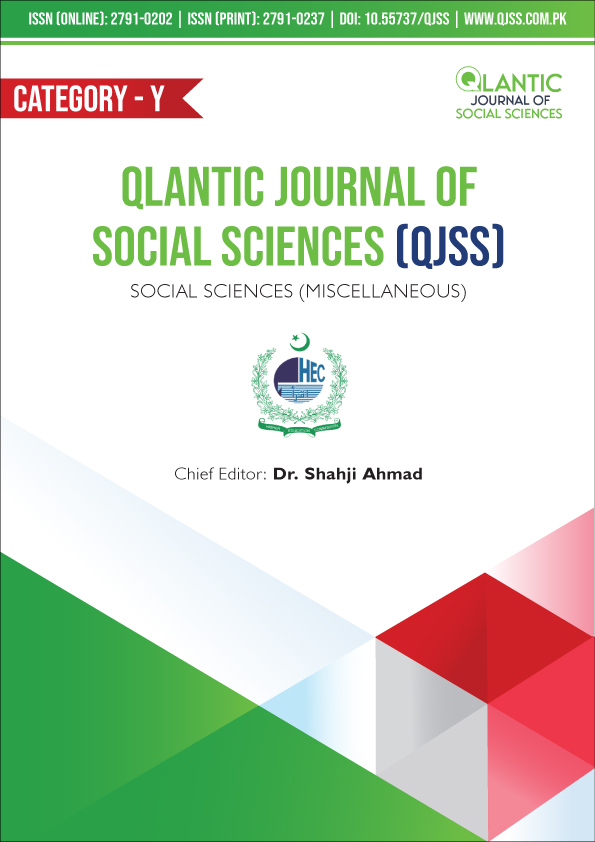Students Attitudes Toward Learning English as a Second Language in Colleges of Gilgit-Baltistan
DOI:
https://doi.org/10.55737/qjss.v-iv.24301Keywords:
Attitudes, English as a Second Language (ESL), Gender-Based Differences, SPSS, Behavioral, Gilgit BaltistanAbstract
This study investigates students' attitudes toward learning English as a second language in the colleges of Gilgit-Baltistan and explores gender-based differences through statistical tools. This research follows Gardner’s (1985) framework. The data is collected from 70 students enrolled in various colleges across Gilgit-Baltistan through questionnaires using a Likert scale and is analyzed using both qualitative and quantitative research methods. The findings of this research reveal that the majority of language-learning students in colleges across Gilgit-Baltistan hold a positive attitude toward learning English in behavioral, cognitive, and emotional learning areas. Students recognize English as a crucial language for academic and career advancement. Moreover, they express a strong desire to improve their language skills and acknowledge the importance of English in the modern world. These findings highlight the need for implementing effective strategies to overcome challenges and create a conducive learning environment for language learners. Furthermore, a T-test was applied using SPSS, and the findings show that both male and female students have the same perception regarding language attitudes. The statistical significance of this research lies in its potential to help policymakers, educators, and other stakeholders involved in English language education in Gilgit-Baltistan.
References
Abidin, M. J., -Mohammadi, M., & Alzwari, H. (2012). EFL students’ attitudes towards learning English language: The case of Libyan secondary school students. Asian Social Science, 8(2), 121. https://doi.org/10.5539/ass.v8n2p119
Abu-Snoubar, T. K. (2017). an evaluation of efl students’ attitudes toward english language learning in terms of several variables. English Language Teaching, 5(6), 18-34. https://doi.org/10.1016/j.sbspro.2010.12.258
Ahmed. (2015). Attitudes towards English Language Learning among EFL Learners at UMSKAL. ERIC - Education Resources Information Center. https://files.eric.ed.gov/fulltext/EJ1079681.pdf
Alkaff. (2013). Students’ Attitudes and Perceptions towards Learning English. Arab World English Journal INTERNATIONAL PEER REVIEWED JOURNAL ISSN: 2229-9327 ج, AWEJ Volume.4 Number.2, 2013 (2013), Pp.106-121. https://doi.org/10.18057/ijasc.2013.9.4
Anonby, E., Gheitasi, M., & Aliakbari, M. (2017, June). Revisiting language distribution in Ilam Province. In 3rd International Conference on Kurdish Studies (ICKS3), University of Exeter.
Crystal, D. (1997). English as a Global Language. Cambridge: Cambridge University Press.
Delić, H. (2020). "Attitude towards learning English as a foreign language". Journal of Education and Humanities, 3(1). https://doi.org/10.14706/jeh2020316
Ellis, N. C. (2007). Blocking and learned attention in language acquisition. In Proceedings of the Annual Meeting of the Cognitive Science Society (Vol. 29, No. 29). https://escholarship.org/uc/item/7xk0g6n4
Ellis, R. (1994). The Study of Second Language Acquisition. Oxford: Oxford University Press.
Firdous, M., Khan, A. A., & Masood, M. H. (2022). The Effectiveness of Process-Genre Approach as a Teaching Method of Academic Writing. Journal of Educational Research and Social Sciences Review (JERSSR), 2(4), 56-68.
Gardner, R. C., Lalonde, R. N., & Moorcroft, R. (1985). The role of attitudes and motivation in second language learning: Correlational and experimental considerations. Language Learning, 35(2), 207–227. https://doi.org/10.1111/j.1467-1770.1985.tb01025.x
Gömleksiz, M. N. (2010). An evaluation of students’ attitudes toward English language learning in terms of several variables. Procedia - Social and Behavioral Sciences, 9(2010), 913-918. https://doi.org/10.1016/j.sbspro.2010.12.258
Graddol, D. (2006). English next (Vol. 62). London: British council.
Hashwani, M. S. (2008). Students’ attitudes, motivation and anxiety towards English language learning. Journal of Research and Reflections in Education, 2(2). https://ecommons.aku.edu/pakistan_ied_pdck/7
Herwiana, S., & Laili, E. N. (2021). Students’ attitude towards English language learning. Journal of Educational Method and Technology, 2(3). https://doi.org/10.36412/jemtec.v2i3.1026
Holmes, J. (1992). Women's talk in public contexts. Discourse & society, 3(2), 131-150. https://doi.org/10.1177/0957926592003002001
Jain, V. (2014). 3D model of attitude. International journal of advanced research in management and social sciences, 3(3), 1-12.
Kara, A. (2009). The effect of a'learning theories' unit on students' attitudes toward learning. Australian Journal of Teacher Education (Online), 34(3), 100-113. https://search.informit.org/doi/10.3316/ielapa.787886372821933
Le, X. M., & Le, T. T. (2022). Factors affecting students’ attitudes towards learning English as a foreign language in a tertiary institution of Vietnam. International Journal of TESOL & Education, 2(2), 168-185. https://doi.org/10.54855/ijte.22229
Masood, M. H., Shafi, S., Yousaf Rahim, M., & Darwesh, M. A. (2020). Interference of L1 (Urdu) in L2 (English) in Pakistan: Teaching English as a second language. International Journal of Applied Linguistics and English Literature, 9(5), 110. https://doi.org/10.7575/aiac.ijalel.v.9n.5p.110
Ming, T. S., Ling, T. S., & Jaafar, M. N. (2011). Attitudes & Motivation of Malaysian Secondary Students towards Learning English as a Second Language: A Case Study. The Southeast Asian Journal of English Language Studies, 17, 40-45
Ong, J. E. (2021). Attitudes of Filipino senior high school students towards English: Implications for teaching English. ACE Official Conference Proceedings. https://doi.org/10.22492/issn.2186-5892.2021.34
Oroujlou, N., & Vahedi, M. (2011). Motivation, attitude, and language learning. Procedia - Social and Behavioral Sciences, 29, 994-1000. https://doi.org/10.1016/j.sbspro.2011.11.333
Pham, D. T., & Nguyen, T. H. (2021). A study on attitude towards English language learning among non-English majored students at tra Vinh University. Vietnam Journal of Education, 4(2), 47-54. https://doi.org/10.52296/vje.2020.19
Roshin, I., Shafi, S., & Masood, M. H. (2023). Enhancing ESL Classroom Management and Language Proficiency: A Gamification Approach in Pakistani Universities. GUMAN, 6(4), 221-234.
Shafi, S., & Masood, M. H. (2023). Pedagogical approaches in English language learning (ELL): Comparative analysis of teacher-centred approach and student-centred approach. Research Highlights in Language, Literature and Education Vol. 7, 68-77. https://doi.org/10.9734/bpi/rhlle/v7/5341b
Sharma, L. R. (2022). Appraising bachelor first year education students’ affective, behavioral and cognitive attitudes towards learning English. Global Academic Journal of Linguistics and Literature, 4(3), 56-65. https://doi.org/10.36348/gajll.2022.v04i03.003
Sharma, L. R. (2022). Bachelor first year education student’s attitude towards learning English. International Research Journal of MMC, 3(1), 57-69. https://doi.org/10.3126/irjmmc.v3i1.44195
Starks, D., & Paltridge, B. (1996). A note on using sociolingustic methods to study non-native attitudes towards English. World Englishes, 15(2), 217-224. https://doi.org/10.1111/j.1467-971x.1996.tb00107.x
Zulfikar, T., Dahliana, S., & Sari, R. A. (2019). An exploration of English students’ attitude toward learning English. English Language Teaching Educational Journal, 2(1), 1-12. https://doi.org/10.12928/eltej.v2i1.947




